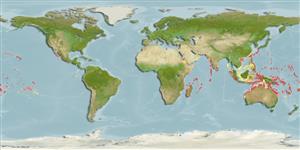Common names from other countries
>
Gobiiformes (Gobies) >
Microdesmidae (Wormfishes) > Ptereleotrinae
Etymology: Ptereleotris: Greek, pteron = wing, fin + The name of a Nile fish, eleotris (Ref. 45335).
More on author: Fowler.
Environment: milieu / climate zone / depth range / distribution range
Ecología
marino asociado a arrecife; rango de profundidad 2 - 31 m (Ref. 1602), usually 2 - 4 m (Ref. 1602). Tropical; 22°C - 28°C (Ref. 27115); 30°N - 30°S
Indo-Pacific: Red Sea and islands in the western Indin Ocean (Ref. 528) to the Line and Marquesas Islands, north to the Ryukyu Islands, south to the southern Great Barrier Reef; Mariana and Marshall Islands in Micronesia.
Tamaño / Peso / Age
Maturity: Lm ? range ? - ? cm
Max length : 12.0 cm SL macho / no sexado; (Ref. 48637)
Espinas dorsales (total) : 7; Radios blandos dorsales (total) : 27 - 29; Espinas anales: 1; Radios blandos anales: 25 - 28; Vértebra: 26. Yellowish to greenish gray in color; lower half of eye to ventral of chin nearly enclosed by a broad blue-edged dark red to purple area; opercle with 2 diagonal bright blue bands; pectoral fin base with an orange-red bar broadly bordered with bright blue. Chin barbel followed by a median longitudinal fold. Fins yellowish; 2nd dorsal a median longitudinal row of blue spots.
This schooling species inhabits exposed seaward reefs in relatively shallow water, over hard bottoms. Usually many individuals occupy the same refuge. Found to be subjected to strong currents, where in small to large aggregations (Ref. 48637). Feeds on zooplanktons (Ref. 89972).
Life cycle and mating behavior
Maturities | Reproducción | Spawnings | Egg(s) | Fecundities | Larva
Randall, J.E. and D.F. Hoese, 1985. Revision of the Indo-Pacific dartfishes, genus Ptereleotris (Perciformes: Gobioidei). Indo-Pac. Fish. (7):36 p. (Ref. 528)
IUCN Red List Status (Ref. 130435)
CITES (Ref. 128078)
Not Evaluated
Threat to humans
Harmless
Human uses
Pesquerías: comercial; Acuario: Comercial
Herramientas
Special reports
Download XML
Fuentes de Internet
Estimates based on models
Preferred temperature (Ref.
115969): 25 - 29.3, mean 28.2 (based on 2283 cells).
Phylogenetic diversity index (Ref.
82804): PD
50 = 0.5000 [Uniqueness, from 0.5 = low to 2.0 = high].
Bayesian length-weight: a=0.00389 (0.00180 - 0.00842), b=3.12 (2.94 - 3.30), in cm Total Length, based on all LWR estimates for this body shape (Ref.
93245).
Nivel trófico (Ref.
69278): 3.4 ±0.45 se; based on food items.
Fishing Vulnerability (Ref.
59153): Low vulnerability (10 of 100).
